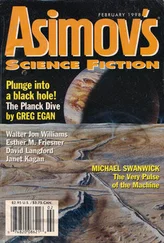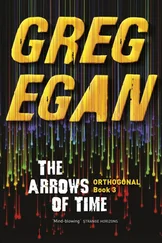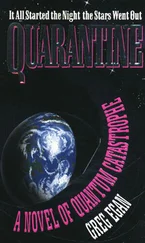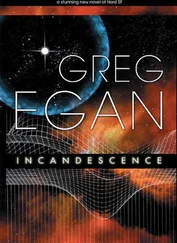Greg Egan - The Clockwork Rocket
Здесь есть возможность читать онлайн «Greg Egan - The Clockwork Rocket» весь текст электронной книги совершенно бесплатно (целиком полную версию без сокращений). В некоторых случаях можно слушать аудио, скачать через торрент в формате fb2 и присутствует краткое содержание. Жанр: Фантастика и фэнтези, на английском языке. Описание произведения, (предисловие) а так же отзывы посетителей доступны на портале библиотеки ЛибКат.
- Название:The Clockwork Rocket
- Автор:
- Жанр:
- Год:неизвестен
- ISBN:нет данных
- Рейтинг книги:3 / 5. Голосов: 1
-
Избранное:Добавить в избранное
- Отзывы:
-
Ваша оценка:
- 60
- 1
- 2
- 3
- 4
- 5
The Clockwork Rocket: краткое содержание, описание и аннотация
Предлагаем к чтению аннотацию, описание, краткое содержание или предисловие (зависит от того, что написал сам автор книги «The Clockwork Rocket»). Если вы не нашли необходимую информацию о книге — напишите в комментариях, мы постараемся отыскать её.
The Clockwork Rocket — читать онлайн бесплатно полную книгу (весь текст) целиком
Ниже представлен текст книги, разбитый по страницам. Система сохранения места последней прочитанной страницы, позволяет с удобством читать онлайн бесплатно книгу «The Clockwork Rocket», без необходимости каждый раз заново искать на чём Вы остановились. Поставьте закладку, и сможете в любой момент перейти на страницу, на которой закончили чтение.
Интервал:
Закладка:
“What’s the great achievement?” Yalda called after her.
“You have to see this for yourself!” Isidora replied.
The walls of the optics workshop were kept free of the ubiquitous luminous moss, so the room’s deep shadows and controlled lamplight made it eerily reminiscent of its counterpart in Zeugma University—with the surreal placement of people and equipment only heightening Yalda’s sense of wandering into a nostalgic hallucination. Isidora was waiting in a corner where Sabino, a young researcher, was operating one of the microscopes, while clinging to two wooden bars that ran between the erstwhile floor and ceiling.
The microscopes had been back in action for days. Yalda approached, intrigued.
“What’s the new development?” she asked. Two closely spaced clearstone slides were positioned at the focus of the instrument; whatever they enclosed was—unsurprisingly—too small to discern with the naked eye, but they were attached to an elaborate mechanism of levers and wheels that Yalda hadn’t seen before, with a slender rod reaching into the space between them. In front of the small sunstone lamp that was illuminating the specimen was a thin slab of material that she recognized as a polarizing filter.
Sabino said, “Please, take a look for yourself.” He was shy with Yalda, but she could see that he was at least as excited as Isidora.
He moved aside and let Yalda take the bars in front of the microscope. Even the solid wood trembled a little from the shifting forces as they changed places; Yalda waited for the vibrations to die down, then peered into the eyepiece.
The field was full of translucent gray specks, most of them roughly spherical, albeit with jagged outlines. Shape aside, they possessed no visible features, no apparent parts or fine structure. Not all of the specks were in focus; the slides hadn’t been pressed together tightly enough to touch the material, to hold it in place. But the focal plane of the microscope had been adjusted to take in one particular speck; this one was fixed, gripped by a tiny pair of callipers that appeared solid black in their opacity. The other specks, though unconstrained, were barely quivering, demonstrating that the air between the slides was almost motionless.
“What am I looking at?” Yalda asked.
“Powdered calmstone,” Sabino replied.
“Under polarized light?”
“Yes.”
A pinch of fine sand—ground from calmstone or anything else—would not normally look like this. The grains would generally appear variegated in polarized light, made up of half a dozen regions of very different shades of gray. These were uniform, homogeneous.
“So you sorted them?” Yalda asked Sabino. “You picked out the purest grains you could find?”
“Yes. Maybe one in ten gross were like this.”
“One in ten gross ? You’ve been busy.”
Yalda hadn’t had time to learn about Sabino’s project since coming up from the navigators’ post, but she could guess the rationale for his painstaking efforts. If solids such as calmstone were composed of regular arrays of indivisible particles—such as Nereo’s putative luxagens—then the best way to study their properties would be to obtain pieces of the material in question in which the array was as close to geometrically flawless as possible. An array of particles that maintained a regular pattern should have the same optical properties throughout; the usual mottled appearance of sand under polarized light ruled that out, but by chance there could always be exceptions. Sabino had found those exceptions, and discarded everything else.
“Try moving the wheel,” he suggested. “The top one on your right.”
Without looking away from the eyepiece, Yalda reached up with the right hand of the pair that sprouted from her chest, and found the wheel. She drew her fingertip along the rim, nudging it very slightly. In response, the callipers between the slides shifted, dragging their tiny cargo some fraction of a scant.
“What am I missing?” she asked. She didn’t think anyone expected her to be impressed by the fact that they could move single grains of sand around.
“Don’t just look at the callipers,” Isidora urged her. “Watch what’s happening around them.”
Yalda turned the wheel gently again; something caught her eye, but as soon as she stopped to try to scrutinize it, it ceased attracting her attention.
She moved the wheel a little more, then when the unexpected thing she hadn’t quite seen began to happen again, she started jiggling the wheel back and forth: jiggling the callipers, jiggling the tiny piece of calmstone it held.
As she did so, a second piece beside it moved in lockstep. Light was visible between the two; they were not touching. But whatever she did to the captive grain, its mimic followed as if they were two parts of a single, rigid body.
“Nereo’s force,” she said softly. “This is it? We can actually see it?”
Isidora chirped with glee, treating the question as rhetorical. Sabino was more cautious. “I hope that’s what it is,” he said. “I can’t think of any better explanation.”
According to Nereo’s equation, every luxagen should be surrounded by furrows of lower potential energy, within which any other luxagen nearby would prefer to reside. For a single luxagen, the furrows would simply be a series of concentric spherical shells, but the same effect acting on a multitude of particles could bind them together in a regular array—and in that case, the pattern of indentations in the energy landscape would extend beyond the array itself, offering the chance for another fragment of a similarly composed material to become ensnared in it. In effect, a sufficiently pure speck of rock could “stick” to another such speck, without the two actually touching.
“You tried this before, when the engines were running?” Yalda asked Sabino.
“Stint after stint,” he replied. “But gravity and friction must have overwhelmed the effect, because I never saw anything like this.”
Which meant that nobody back home could have seen it, either; it was only the condition of weightlessness that had made the experiment viable.
Yalda had been watching Sabino with her rear gaze; now she leaned back from the microscope and turned to face him. “This is excellent work!” she declared. “I’ll want you to give a talk on it to all the researchers, sometime in the next few days. Have you done anything on the theoretical side?”
Sabino produced a sheet of paper from a hold beside the microscope. “So far, only this,” he said.
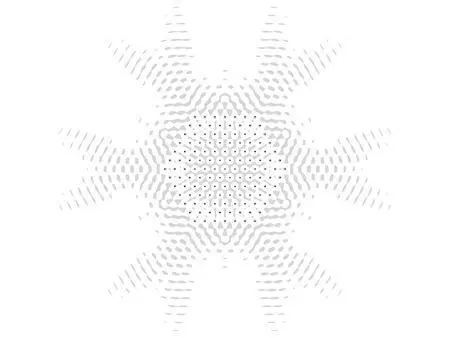
“These are the energy troughs around a hexagonal array of luxagens,” he explained. “I drew it when I was first thinking about this project, back on the ground. It took about four stints to calculate.”
“I can believe that,” Yalda replied. It was a nice example of the kind of pattern that could persist beyond the edge of a solid—and she could easily picture a second array getting caught in those energy pits, like a truck sinking into another’s wheel ruts. She said, “We’re going to need to find ways to estimate the forces arising from much larger arrays, and to take account of the whole three-dimensional geometry. But don’t worry about that for now; you should concentrate on refining this setup.”
“All right.” Sabino was still a bit dazed, and though Yalda was trying to keep him as grounded as possible, he could not have failed to realize the importance of his discovery. If this experiment could be repeated and elaborated upon, it promised to make the nature of matter the subject of systematic inquiry—ending the days when the differences between a stone and a puff of smoke had no better explanation than the empty incantation that “solid objects occupy space”. Nereo had paved the way, but until now all his beautiful mathematics had remained untested guesswork. It was possible that Sabino and Nereo would be spoken of alongside Vittorio, who had made sense of the orbits of the planets—but Yalda thought it best not to overwhelm the young researcher with florid praise and promises of immortality. What he needed to do now was pursue the work itself.
Читать дальшеИнтервал:
Закладка:
Похожие книги на «The Clockwork Rocket»
Представляем Вашему вниманию похожие книги на «The Clockwork Rocket» списком для выбора. Мы отобрали схожую по названию и смыслу литературу в надежде предоставить читателям больше вариантов отыскать новые, интересные, ещё непрочитанные произведения.
Обсуждение, отзывы о книге «The Clockwork Rocket» и просто собственные мнения читателей. Оставьте ваши комментарии, напишите, что Вы думаете о произведении, его смысле или главных героях. Укажите что конкретно понравилось, а что нет, и почему Вы так считаете.


